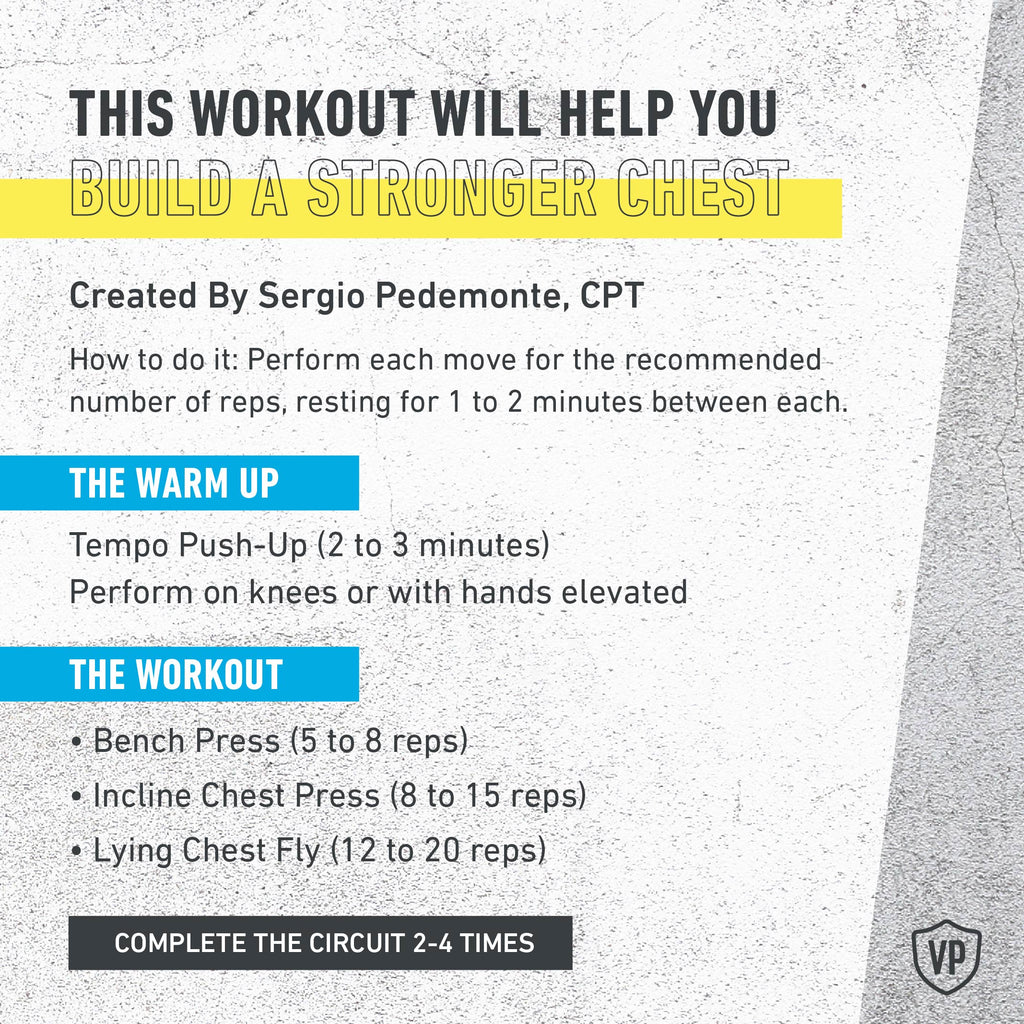Strong, defined pecs aren't just for superheroes. You can build strong chest muscles (made up of the pectoralis major and the pectoralis minor) through well-rounded mechanics of a solid chest workout routine.
Doing so makes everything from pushing and pulling objects to even breathing easier, and can help improve your posture.
Ready to get started? Grab a Vital Performance™ Protein Bar to fuel up, and get ready to build the ultimate chest workout routine with tips from fitness experts.
Vital Note: This article has been made available for informational and educational purposes only. It is not intended to be a substitute for professional medical advice, diagnosis, or treatment. Always seek the advice of your physician or another qualified health provider with any questions you may have regarding a medical condition. Your licensed healthcare professional can best provide you with the diagnosis and treatment of any medical condition and assist you as well in deciding whether a dietary supplement will be a helpful addition to your regimen.
How many workouts should I do on chest day?
Don't let a poorly planned workout hold you back. To determine how many workouts to do on chest day, you first need to determine your goals, according to Sergio Pedemonte, CPT and CEO of Your House Fitness. For example, if you're looking to strengthen the chest muscles without dramatically increasing muscle mass, try a limited number of exercises.
"When training for strength, the majority of the focus will be on one main movement, followed by two assistance exercises which are utilized to support the main exercise," he tells Lively.
When your goals are the opposite – you want that bigger chest — then increase the number of exercises per workout.
"In any one workout, three to four exercises for the chest are optimal," says Pedemonte. For more variety, you could go up to six to eight exercises (performed safely) before you risk repeated wear and tear injuries.
What is a good chest workout routine?
For a truly pecs-tacular chest workout routine, you want two things: functional "press" exercises and isolation exercises. Functional "press" exercises can also be described as exercises that move more than one joint at a time.
Pedemonte says that there is great benefit to doing these kinds of heavy load exercises first since they have the highest risk of injury when performed in a fatigued state.
The next component to a good well-balanced chest workout routine are isolation exercises, such as dumbbell flys.
Related Articles
How many times a week should I work out my chest?
Just as you should never skip leg day, the same rule applies for the chest. As with everything, how many chest workouts you do per week depends on your fitness level and goals. Beginners should start with one chest workout per week, recommends David Sautter, NASM certified personal trainer for Top Fitness Magazine.
"Once you have experience, you've strengthened your neuromuscular connections, and you are confident in your form, then you can progress to two chest workouts per week," Sautter says, adding that this can be broken down into a few full-body workouts or two upper-body focused workouts. As with any fitness program, the specifics of this are tailored to your individual goals.
Recovery time is a huge consideration. "You don't want to overtrain a muscle group as this can do the complete opposite of what you are wanting to achieve," says Sarah Rector, CPT, creator of The SLR LIFE Method. Depending on how heavy you are lifting, Gillian Sykes, CPT and nutritionist, recommends at least two to three days in between chest workouts.

What are the 5 chest workouts?
Ultimate muscle-building starts with these five chest exercises.
1. Bench press: "The bench press/ incline press are great chest exercises for heavily loading the muscle," explains Sautter. "Heavy loads on the muscle are an important stimulus when training because it shocks the chest into growth."
2. Bench Dip and Push-Up: According to Pedemonte, dips and push-ups are closed chain exercises. This means that they "help promote stability within the shoulder joint and will help keep your joints and ligaments healthy if done correctly."
3. Dumbbell Fly: There is so much versatility with this movement. By simply adjusting the bench level (decline, flat, incline), Sautter says that you can target each section of the pectoral muscle.
4. Chest Fly: These exercises give you a great opportunity to really squeeze the chest muscles. "Chest flys are exercises that place a large amount of tension at the stretched portion of the movement which is great for building strength and stability of the chest and shoulder at end ranges," says Pedemonte. However, he cautions that this movement can be risky for the shoulder joint if performed too heavy.
Try this instead: “Performing chest flys on the ground rather than a bench will prevent the arms from traveling beyond the chest’s range of motion and is safer for those with shoulder pain.”
5. Banded Dumbbell Press: Similar to the dumbbell fly, Sautter explains that you can target each section of the pectoral muscle by adjusting the bench level (decline, flat, incline).
For the sake of safety, Justin Meissner, a performance and mobility coach, says to be in control of each of the movements for safety. "Having too heavy a weight or doing a movement without actually engaging your chest can cause injury," he says. "Always make sure you are aware of your capabilities when working out."
Do push-ups work your chest?
The humble push-up deserves to brag for a minute. In addition to being one of the most convenient exercises around (it requires only the use of your bodyweight), it also packs a serious punch when working the chest. "Push-ups are great exercises for developing chest musculature, shoulder stability and total body coordination," Pedemonte tells Lively.
Plus, you don’t need any weights, adds Sykes.
Push-ups can be used in anyone's training routine, regardless of experience, due to closed chain aspects of this exercise, explains Pedemonte.
"Often when individuals only train open chain exercises, such as bench press, they develop faulty movement patterns which may result in shoulder or elbow pain," he says. "Push-ups train the chest to work in unison with the rest of the body and will encourage proper pressing movement."
Much like the barbell bench press, you can also target each section of the pectoral muscle through adjustments. For example, Sautter says that you can alter the level of the push to activate different sections of the muscle i.e., an incline push-up.
Chest workout routine
Get on your way to strengthening your chest muscles with this workout provided by Pedemonte. You can use the recommended number of sets included or start the workout on the low end of the sets and progressively add sets throughout 4 to 6 weeks as your body adapts.

The Warmup:
Tempo pushups
Perform 2-3 minutes of kneeling push-ups or push-ups with your hands elevated on a bench to reduce the effort needed is optimal for warm-ups.
This is your warmup to activate the proper musculature. "The goal is to focus on stabilizing the shoulder while feeling the chest contract" says Pedemonte.
The Workout:
Bench Press
Perform 2-4 sets of 5-8 reps, saving 1 rep in the tank for safety purposes. Rest roughly 2 minutes or until fully recovered.
Incline Chest Press Machine
Perform 2-4 sets of 8-15 reps.
This second exercise is designed to pump blood into the muscle. Pedemonte advises that the rest period for this exercise be shorter than for the bench press. "Full recovery is still advised before entering the next set to maintain the blood pump within the chest."
Lying Chest Fly
Perform 2-4 sets of 12-20 reps with lighter weight. The rest time should be enough to fully recover but also brief. "The focus with this exercise is slow and controlled stretching of the chest," he says.













